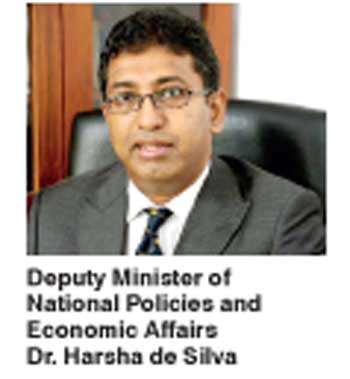Friday Nov 15, 2024
Friday Nov 15, 2024
Saturday, 11 November 2017 00:50 - - {{hitsCtrl.values.hits}}
 The Government has obtained Rs.1.516 trillion worth debt in 2016, Deputy Minister of National Policies and Economic Affairs Dr. Harsha de Silva confirmed in Parliament yesterday.
The Government has obtained Rs.1.516 trillion worth debt in 2016, Deputy Minister of National Policies and Economic Affairs Dr. Harsha de Silva confirmed in Parliament yesterday.
The weighted average yield rate (WAYR) due to the total debt obtained in the form of treasury bills from the domestic market for short-term and long-term instruments were 9.99% and 13.58% respectively. The WAYR for Sri Lanka Development Bonds, which is a domestic US dollar denominated medium term instrument was held at 5.13% and the WAYR for International Sovereign Bonds, which is also a foreign US dollar denominated medium term instrument was offered 6.47%. The WAYR for loans from the foreign currency banking units (FCBU) for US dollar denominated medium term instruments for the domestic market was offered 3.95% in 2016.
According to the Deputy Minister, there have been fluctuations in weighted average interest rates in the year 2016 in comparison to years 2014 and 2015. “WAYR for treasury bills has increased by 2.7% in 2016 compared to 2014 and increased by 2.77% compared to 2015. WAYR for treasury bonds has increased by 3.35% in 2016 compared to 2014 and increased by 3.31% compared to 2015. WAYR for Sri Lanka Development Bonds has increased by 1.37% last year compared to 2014 and increased by 1.21% compared to 2015.
WAYR for international sovereign bonds, has increased by 0.76% in 2016 compared to 2014 and increased by 0.17% compared to 2015. WAYR for loans from FCBU has increased by 0.38% in 2016 compared to 2014 and decreased by 0.54% compared to 2015,” Dr. de Silva told Parliament, confirming that the Government has refrained from borrowing at excessive rates.
Stating that prudent action led to obtaining debt at competitive rates compared to what he called the failed debt management followed during the Rajapaksa regime, the Minister said: “A massive shift in rates took place in the world. This global phenomenon led even to change the deflation and the negative rates in Japan. So, the interest rates started going up around the globe. Sri Lanka is a small nation and will obviously have to face the global rates. We can remember that during the previous Government, dollar denominated loans were obtained at 9.99%. But we haven’t resorted to such borrowings.”
“There are fundamental causes of interest rate fluctuations in Sri Lanka. For an example, we had to propose a 20 cent tax per Rs.1,000/- to be recovered from banks to pay back the loans obtained during the Rajapakse regime. The Medamulana Tax was imposed to settle the massive debt we are left with and have no ways to pay back. We can’t mint money. But there can be different opinions between the rates and the controversial bond issuance. I agree that the culprits behind it should be imprisoned and the keys be thrown away. However, if we go beyond political statements, there is no clear indication that there is a direct relation between the controversial bond issuance and the rising rates. There are yield curves sometimes upward and sometime downward slopes. The rates are dependent on the budget deficits. The interest rate is a function of many factors,” explained the Deputy Minister in response to a supplementary question raised by UPFA Joint Opposition Parliamentary Group member MP Udaya Gammanpila.